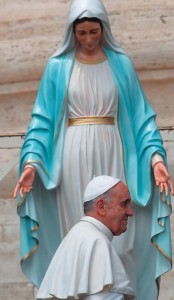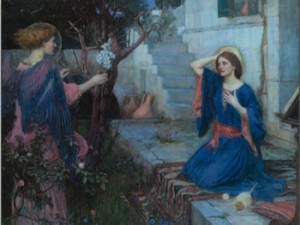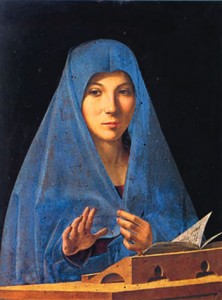Mary for Today – Mary for the Third Millennium (2)
Mary, Model for the Church
In an insightful comment Karl Rahner reminded us that it was the image of the woman Mary that enabled the church in past centuries to prevent society, with which it was too uncritically identified, from setting up a purely patriarchal domination. He adds that the Church had to learn slowly and painfully amid the changes in secular society: “To give woman what is her due by nature and by right: an historical process which is still far from complete. But in its understanding of faith the Church has a starting point of its own for this process. And what is its own is in fact present as an archetype in its image of Mary”. (Mary and the Christian Image of Woman, in Theological Investigations Volume XIX, 1983).
Hans Urs von Balthasar, a theologian greatly admired by Pope John Paul II, complained about the imbalance of male and female principles in the church so that “it has to a large extent put off its mystical characteristics; it has become a church of permanent conversations, organisations, advisory commissions, congresses, synods … structures and restructuring, statistics, that is to say, more than ever a male church, if perhaps one should not say a sexless entity”.
And again in his fear that Christianity threatens imperceptibly to become inhuman, he adds: “In this masculine world, all that we have is one ideology replacing another, everything becomes polemical, critical, bitter, humourless, and ultimately boring, and people in their masses run away from the church”. (1975, Elucidations, 72-74).
 Establishing the Balance
Establishing the Balance
The mystical and feminine dimensions are vital for Church life. When Christianity finds the women in the church then it will find the Woman of the church. By the time the Second Vatican Council was called, a certain imbalance had developed with respect to Marian devotions. Many bishops were keenly aware that for some Christians, Marian devotions were more important than the celebration of the Eucharist. Earlier, this series considered the heated debate at Vatican II and the far-reaching impact of including Mary within the Document on the Church (Lumen Gentium).
For many Catholics Vatican II’s orientation to Mary has been puzzling, if not downright disappointing. So many familiar, well-loved devotions have all but disappeared. The implications of the Council’s teaching on Mary is neither understood nor appreciated by those who have not had the chance to explore them. But for those Christians who have moved with the Council, a growing realisation of Mary’s ongoing role in the life of the Church has been a most welcome sign of authentic renewal and reform.
In our historical investigation of the changing faces of Mary through history, we saw how at each new historical moment for Christians, the mystery of Mary unveils a different facet, one that deeply touches the needs especially of the poor and believing people, though also the rich and powerful aristocracy, and places women in active participation on an equal basis with men. This perspective is not yet something achieved in our era, but it is being announced strongly and vigorously, and along with Mary, brings life to the future.
“Mary wears whatever face can be recognised by particular people at particular moments. When that face is true to the woman of the New Testament, it demands a whole response, both inner humility and outer justice, similar to the one Mary expressed in her Magnificat: ‘He has thrown down the rulers from their thrones, but lifted up the lowly’.” (Cuneen, 1996, In Search of Mary, p.24)
Mary and Devotions
We must be slow to make superficial or hasty judgments about the popular religious imagination and piety, either in its popular preaching or devotional expressions, however odd they appear to us today. The simpler Catholic faithful, especially the poor and deprived have sought in Mary a strength which enabled them to interpret life, to experience the love of God in their lives, to feel accompanied and not abandoned, and to continue to hope, no matter how bad the circumstances and tragedies of their lives. It was the task of Vatican II to bring Marian devotion within the limits of sound theology and practice.
It is never easy to live in a time of great change. People tend to be defensive when something new is presented, and ask “Were we wrong in what we did?” Jesus’ own experience when he proclaimed his new message into history, the Reign of God, was opposed by the most religious groups in his society, the priestly Sadducees and the pious Pharisees. Why the opposition? Because they were so sure they were right. Jesus never bluntly told them they were wrong. He called on them to consider that there may well be other ways of seeing things, ways that might well lead to better living and growing in the love of God. This message is a vital necessity in a fragmented church.
A Mariology for our times is not just a matter of Western or/and feminist issues. I have drawn on the Sri Lankan theologian, Fr. Aloy Pieris (The Christhood of Jesus and the Discipleship of Mary, 2000), and Hyun Kyung Chung (Struggle to be the Sun Again: Introducing Asian Women’s Theology, 1990), who asks a vital question, “Who is Mary for Today’s Asian Women?” I have pointed you towards every age forming its own picture of Mary, in accord with its picture of discipleship.
Mary and Scripture
I would like again to touch on the lines of Mariology I see developing in our times out of the Vatican II Document on the Church (Lumen Gentium) and Marialis Cultus. It must be solidly based on Scripture. There was a real concern at Vatican II that Mariology had lost its contact with its biblical sources. To some extent the Protestant stance of ‘Scripture alone’ contributed to the situation that little Mariology or even theology was built on the Bible. But now we are told firmly that “The Bible is the basic prayer book of Christians. Devotion to the Blessed Virgin cannot be exempt” (Marialis Cultus #30). Some of the best work on Mary has come from biblical scholars whose work has had considerable ecumenical appeal.
There is a developing perspective that captures our attention when we see Mary as a model for the ministry of the Word, for the world and the Church. What the gospels do for Mary is to show an understanding of her role as mother, virgin, and disciple that is often different from the one we have traditionally been given. The virginity of Mary in the gospels is her openness to the Word; she has the proper interior dispositions to welcome the Word. As mother, she nourishes the Word while being nourished by it, the pondering that holds together and waits patiently on the tensions in her life. Third is the most pronounced feature of her personality in the Gospels – her discipleship, which leads her to follow the Word, even to its disclosure on the Cross. It is as virgin, in openness to the Word, as mother in giving life to that Word, and as disciple in putting it all together in life, Word and deed, that Mary is honoured, and anyone who aspires to ministry must, like her, give life to the Word. As Fr. Aloy Pieris said to a meeting of Marist Brother Provincials and leaders, “We must conceive the Word and help it grow before we can give it to others”.



 Entries(RSS)
Entries(RSS)